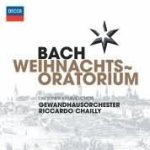Riccardo Chailly and his Dresden and Leipzig forces have created a great modern interpretation of Bach’s Christmas Oratorio that realizes the truest elements of period-performance practice while employing the timbres of modern instruments and fully exploiting the refined virtuosity possessed by today’s finest singers and orchestral musicians. At first, the atmosphere (this recording was made from two concert performances in Leipzig last January) and particular character of the orchestral sound reminded me of when I first heard recordings of Bach’s choral works–in the pre-period-performance days of the 1960s–and the connection was immediately reassuring: this was a solid and informed and, most importantly, deeply felt performance by all concerned.
But just as immediately, you notice how incredibly crisp and clean and vibrant is the playing and singing–how lively the rhythms, how robust yet nimble the brass, how fleet and fluent the strings. This is not big-orchestra, baroque-period technique from the ’60s! This is the way contemporary players and singers do it–they simply perform the daylights out of the music, in the best sense of the term.
Yes, Chailly tends to like tempos just slightly more brisk (sometimes more than “slightly”) than other conductors prefer (Jacobs, on one of my reference recordings, for instance), especially in the choruses, and for others this approach usually doesn’t turn out so well; but the thing is, this choir and orchestra can do it, and do it well. Chailly never pushes them beyond what is musically defensible or technically doable. The opening chorus of Part 1 is properly stunning; the even more impressive chorus that begins Part 5 is a knockout, a true evocation of its text: “Let Thy glory be hymned, O God!”
Usually in works like this, there’s some hitch when it comes to soloists. Not here; they are uniformly excellent. My only complaint (one I invariably lodge) involves bass Konstantin Wolff, whose voice is fine, but his “ha-ha-ha” habit in melismatic runs is not. Outstanding is tenor Wolfram Lattke, who displays amazing technique (and not a hint of “ha-ha-ha”) in his runs–which he sings with incredible speed and apparent ease. Carolyn Sampson impresses (and so does her perfectly matched partner) in the so-called “echo” aria in Part 4 (“Flößt, mein Heiland”), and likewise alto Wiebke Lehmkuhl is lovely and very convincing in her “Schlafe, mein Liebster”.
Chailly must be credited for his well-considered management of time and space–he shapes these six cantatas as individual works but sustains a consistent interpretive approach that works well for listening straight through (not what Bach intended–these were performed at six separate services during the Christmas season of 1734-35). The sound is first-rate, especially when considering the unique demands and exigencies of concert-performance conditions. But then, surely the immediacy and spontaneity of the concert contributed some inspirational spark or two that makes all the difference–that will keep even people like me who weren’t there coming back to this recording often. Highly recommended. [12/15/2010]
































